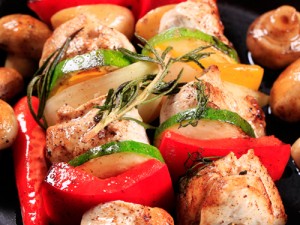Cast-iron skillets may seem like an old-fashioned choice in the kitchen, but this dependable cookware is a must in the modern kitchen. Cast-iron skillets conduct heat beautifully, go from stovetop to oven with no problem and last for decades. (In fact, my most highly prized piece of cookware is a canary-yellow, enamel-coated cast-iron paella pan from the 1960s that I scored at a yard sale for $5.)
As a registered dietitian and associate nutrition editor of EatingWell Magazine, I also know that there are some great health reasons to cook w1ith cast iron:
1. You can cook with less oil when you use a cast-iron skillet
That lovely sheen on cast-iron cookware is the sign of a well-seasoned pan, which renders it virtually nonstick. The health bonus, of course, is that you won’t need to use gads of oil to brown crispy potatoes or sear chicken when cooking in cast-iron. To season your cast-iron skillet, cover the bottom of the pan with a thick layer of kosher salt and a half-inch of cooking oil, then heat until the oil starts to smoke. Carefully pour the salt and oil into a bowl, then use a ball of paper towels to rub the inside of the pan until it is smooth. To clean cast iron, never use soap. Simply scrub your skillet with a stiff brush and hot water and 2dry it completely.
2. Cast iron is a chemical-free alternative to nonstick pans
Another benefit to using cast-iron pans in place of nonstick pans is that you avoid the harmful chemicals that are found in nonstick pans. The repellent coating that keeps food from sticking to nonstick pots and pans contains PFCs (perfluorocarbons), a chemical that’s linked to liver damage, cancer, developmental problems and, according to one 2011 study in the Journal of Clinical Endocrinology and Metabolism, early menopause.
PFCs get released – and inhaled – from nonstick pans in the form of fumes when pans are heated on high heat. Likewise, we can ingest them when the surface of the pan gets scratched. Both regular and ceramiccoated cast-iron pans are great alternatives to nonstick pans for this reason.
3. Cooking with cast iron fortifies your food with iron
While cast iron doesn’t leach chemicals, it can leach some iron into your food – and that’s a good thing. Iron deficiency is fairly common worldwide, especially among women. In fact, 10 percent of American women are iron-deficient. Cooking food, especially something acidic like tomato sauce, in a cast-iron skillet can increase iron content by as much as 20 times.
Eatingwell is a magazine and website devoted to healthy eating as a way of life. Online at www.eatingwell.com.









